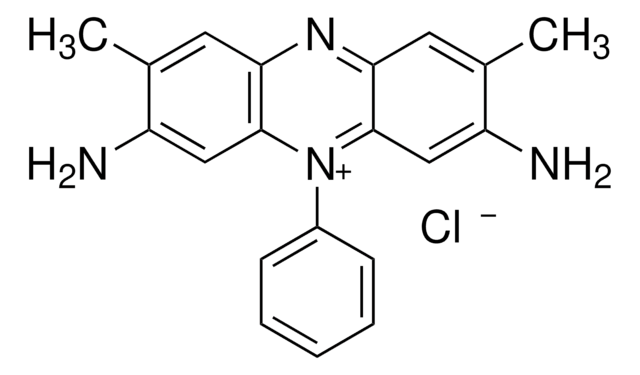V5265
Crystal Violet Solution
1%, aqueous solution
About This Item
Prodotti consigliati
Stato
aqueous solution
Concentrazione
1%
tecniche
microbe id | staining: suitable
Colore
deep violet, purple
Amax
0.36-0.44 at 589-594 nm
applicazioni
diagnostic assay manufacturing
hematology
histology
Temperatura di conservazione
room temp
Stringa SMILE
[Cl-].CN(C)c1ccc(cc1)\C(c2ccc(cc2)N(C)C)=C3/C=C\C(C=C3)=[N+](/C)C
InChI
1S/C25H30N3.ClH/c1-26(2)22-13-7-19(8-14-22)25(20-9-15-23(16-10-20)27(3)4)21-11-17-24(18-12-21)28(5)6;/h7-18H,1-6H3;1H/q+1;/p-1
ZXJXZNDDNMQXFV-UHFFFAOYSA-M
Cerchi prodotti simili? Visita Guida al confronto tra prodotti
Descrizione generale
It stains the fatty portions of sebaceous sweat a deep purple color. Crystal violet can also be used to enhance bloody fingerprints. This dye is harmful if inhaled, swallowed or absorbed through skin, contact may cause cancer, severe eye irritation in human beings.
Applicazioni
- Crystal violet is commonly used in Gram staining for the classification of bacteria.
- It has also been used to detect bacterial adherence to biomedical polymers and to stain DNA in mammalian tissues in Giemsa staining.
- It has been successfully used to develop a counterion-staining method to detect DNA in agarose gel electrophoresis.
- Its antimicrobial properties have facilitated its use in the treatment of oral candidiasis, skin infections, and methicillin-resistant Staphylococcus aureus.
- It has been used as a stain in cell proliferation assays, migration assays, and Boyden chamber assay.
Azioni biochim/fisiol
Principio
Avvertenze
Warning
Indicazioni di pericolo
Consigli di prudenza
Classi di pericolo
Aquatic Chronic 3 - Carc. 2 - Eye Irrit. 2
Codice della classe di stoccaggio
12 - Non Combustible Liquids
Classe di pericolosità dell'acqua (WGK)
WGK 2
Punto d’infiammabilità (°F)
Not applicable
Punto d’infiammabilità (°C)
Not applicable
Elenchi normativi
Forniamo informazioni su eventuali restrizioni prevalentemente per i prodotti chimici. Per altre tipologie di prodotto siamo in grado di fornire soltanto informazioni limitate. Nessuna segnalazione significa che nessuno dei componenti è citato in un elenco. È dovere dell’utilizzatore assicurarsi che il prodotto venga impiegato in maniera sicura e a norme di legge.
EU REACH Annex XVII (Restriction List)
Scegli una delle versioni più recenti:
Possiedi già questo prodotto?
I documenti relativi ai prodotti acquistati recentemente sono disponibili nell’Archivio dei documenti.
I clienti hanno visto anche
Contenuto correlato
An overview of the science and practice of bacteriology in clinical diagnostics. Learn more about the application of standard and special stains for microscopic analysis.
Il team dei nostri ricercatori vanta grande esperienza in tutte le aree della ricerca quali Life Science, scienza dei materiali, sintesi chimica, cromatografia, discipline analitiche, ecc..
Contatta l'Assistenza Tecnica.






